Baliem Valley, West Papua
As the fog clears, steep, jungle-clad mountains loom in the distance. Clouds descend into the valley as they are pierced by the rising sun, painting a picture of solitude and serenity. Up until now, I had believed places of such remote and indescribable beauty only existed in fairy tales. As I crawl out from my smoky hut in the early hours of the morning, it takes an enormous effort to convince myself that this place is even real. This is the Baliem Valley in West Papua’s remote hidden interior, a place where true adventure can still be had. A place where travelers earn their stripes and become explorers; leaving all that they thought they knew behind them. Papua will change you; come prepared.
Getting to the Baliem Valley
The Baliem Valley is located in the central region of West Papua. The task of getting here can be incredibly intimidating, due to remoteness. Do not fret, however, the journey is not as hard as it may appear. With a little patience, getting here can be fairly pain free and exciting.
Jayapura, the Gateway City
Jayapura is the capital city of Indonesia’s West Papua region. Getting here is just a matter of catching a flight from one of Jakarta, Manado, or even Makassar. Usually, the cheapest flights can be found with Lion Air’s “Batik Air.” Flights from most other Indonesian cities, apart from Jakarta, usually connect through Sorong, another city located in the far west of West Papua.
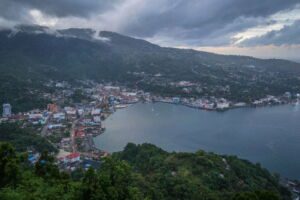
Jayapura itself does not actually have an airport. Instead, you will land at Sentani airport, which is about a 35 km taxi ride to Jayapura city itself, a journey that takes about an hour. Travelers arriving from backpacking in Indonesia will be in shock, as prices here are much higher than elsewhere in the country. Just ask the taxi to drop you off at JL Percetakan in the centre of Jayapura. Here you can find a few hotels for under $25 US per night.
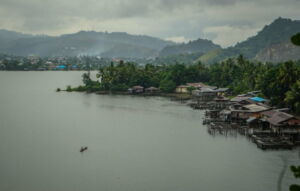
Wamena, Baliem Valley
Wamena is the main “town” in the Baliem Valley. It consists of a few overpriced hotels, a church, military base and a fairly modern airport. Getting to Wamena from Jayapura is not hard at all. On Jayapura’s JL Percetakan Street, you can find many travel agencies who can book you a ticket for next day flights to Wamena from Sentani. There are now several airlines making the trip to Baliem, so getting on a next day flight is a cinch. Again, Lion Air still tends to be the cheapest option for this.
Flying here is an exhilarating experience. The twin prop plane that makes the journey climbs up the mountains,, through puffy clouds over incredible scenery. The turbulence can be pretty intense, so get ready!
When you land you will right away be greeted by the police so they can issue you a Surat Jalan.*
*Surat Jalan: When visiting anywhere in West Papua you will require a Surat Jalan. This travel permit will allow you to access the many regions of West Papua. In Jayapura, you will very rarely be asked for one. If you plan on doing any hiking in Baliem, however you will defiantly need one. The good news is that they are free and easily obtained upon arrival at the Wamena airport. All you will need is a passport photo and thirty minutes of your time.
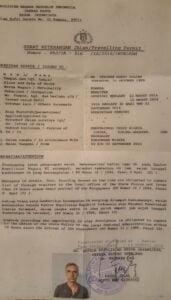
From Wamena’s airport, you can just walk as the town is very small. If walking is not your thing, hop in one of the many cycle rickshaws for about $2 US.
The Dani
The 30 clans that reside in the Baliem and its tributary valleys are known as the Dani. The Dani population consists of around 200 000 people.
These days, most of the Dani speak Bahasa Indonesian, but they also speak their own dialects amongst each other. In the more remote corners of the valley, you will be greeted with the phrase “Wa, Wa,” a common greeting showing respect.

In Wamena, very few of the Dani still wear their traditional outfits, apart from a few elderly men who hang around tourist hotels; selling trinkets and posing for pictures. In the villages scattered around the valley, you can still find elder Dani men donning their penis sheath; made from a gourde. The men also wear a traditional headdress, usually made from either cassowary or chicken feathers. Along with the crown, the men pierce there septum with a pig tusk. Very rarely do you see women in the traditional grass skirt and bare chest apart from in Jinka, where they pose for pictures. On the trails in the highlands you will still see women carrying babies, pigs and sweet potatoes (usually all at once!) in a woven bag known as a noken that is carried with a strap braced on their forehead.
For the most part, the Dani and the rest of Papua have converted to Christianity. Cannibalism, nudity, and culture in general have greatly been affected because of this. One thing that still often happens is clan warfare. Villages have started conflicts with one another over wife and even pig stealing. This practice has been happening here for centuries, although it, too, is starting to die out.
Many Dani still practice polygamy, a tradition they have been practising for centuries. Another odd thing you will notice, while hiking in the Baliem, is that many of the elders are missing fingers. The reason for this is that, in Dani culture, when one loses a child, they bash a finger off with a stone to show that they have lost a loved one.
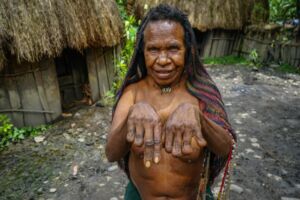
Many of the Dani still choose to live in huts, known as Honai, in closed family compounds. The Honai consists of a large grass roof and usually two levels. The top level is for sleeping, while the bottom is where the residents cook and visit together. One of the best experiences I had in the Baliem was eating sweet potatoes with the locals in a Honai.
Exploring the North Baliem Valley
Traveling in North Eastern Baliem is a great way to experience Dani culture without without having to put in a lot of effort. All the sights can be reached by local bus, or hiring a taxi. I ended up hiring a taxi as it was Sunday, which meant that none the bus’s would be operating until after church in evening. Hiring a taxi for the full day taxi cost $40 US, which I split with three other travelers. We ended up stopping at four different places in the North East.
White Mountain
The first stop was the so called “White Mountain.” This “mountain” is merely a hill that has white ocean sand running down one of its sides. The sand comes from the bellies of birds that have been migrating here from the sea for centuries, slowly building up sand deposits. To be frank, it’s an underwhelming sight. Not to mention that the local chief will demand around $15 US to enter.
Jwinka Village
Further up the valley is the village of Jwinka. Many travelers have labelled this as a “tourist trap,” as locals here dress in traditional clothing mostly just for the benefit of snap happy tourists. All locals will ask for a fee before you can take their photo, but it’s still a great way to see how the Dani here used to dress. There outfits are not just for tourism, however. Most of the men and women who are in this clothing are elders, and have just not transitioned to wearing modern clothing. The elder women will be happy to show you there, amputated fingers as well, an indication of how authentic Jwinka still is.
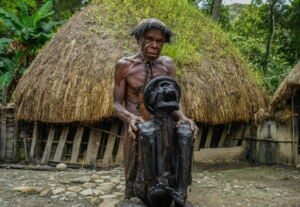
Upon arrival to the village, you will be greeted by the chief. You then will have to negotiate a price for photography, seeing the village and, of course, visiting the Wimontok Mabel Mummy. Wimontok Mabel was a powerful 18th century warlord in the valley. His body was smoked and mummified and has been kept in the village since his death. Nowadays, his mummified corpse can be seen for a small fee of 150 00 RP.
Personally, I loved seeing Jwinka Village. The mummy here was in incredible condition and the locals were very friendly… once we agreed on a price that is. As I am an avid photographer, Jwinka was an opportunity for me to get some great shots. Once you pay, the locals will proudly pose for you and then explain why they wear the jewelry and outfits they do.
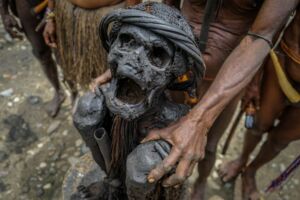
Gua Kotilola
North of Jwinka, high up in the hills is the cave of Gua Kotilola. The cave is accessed by a somewhat muddy foot path that climbs up into the hills from the village near the highway. The local chief takes you up here (for a fee of course) and shows you the different caverns.
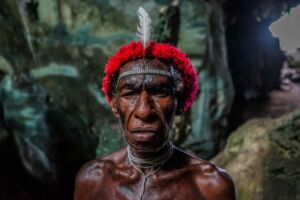
One of the caverns is particularly fascinating. As you crawl past large stalagmites, heading deeper into the cavern, it gets darker and noisier. The noise comes from the thousands of bats who call this cave home. The floor gets slippery from all of the guano; so be careful!
At the end of the cave, you will reach a shallow pool of water. Beyond here is where locals keep the bones of warriors from the past. The chief will not allow you to continue any further, as the spirits of these warriors guard from here on.
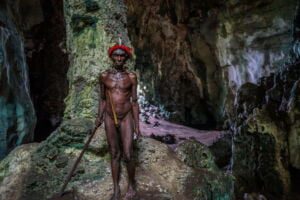
Aikima Village
Heading back to Wamena, our last stop was the small village of Aikima. Relatively hard to find because of the lack of signage, Aikima is home to the oldest mummy in the valley.
The Werapak Elosak mummy was a powerful chief who was mummified by smoking to keep some of his powers in the village. This mummy is famous for how well it was preserved. Werapak Elosak was also mummified with his penis gourde and shell jewellery. It is now approximately 300 years old! The local chief will usually allow you to see the mummy for around 150 00 RP.
I actually preferred seeing this mummy versus the one in Jwinka. The more challenging journey of getting to Aikima made it feel a lot less touristy than Jwinka. The chief had to climb to the top floor of his Honai and drag down the mummy for us to see.
Hiking in the Baliem Valley
The engine sputters as the rusty old van pushes through the muddy road. The air is fresh, and I can see storm clouds brewing in the distant mountains…
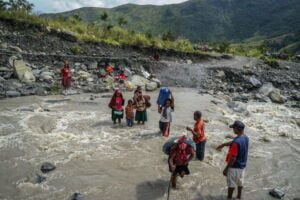
As I rode on the roof of the bus, I peered into the distant valley and contemplated what struggles may lay ahead. The Southern Valley begins to take shape in the distance. Its mountains soar high into the clouds like fortress walls. The clouds move fast, making the weather unpredictable. Finally, the bus comes to a halt, and the driver yells “Kurima!”
My crew consisted of five all together. My travel companion, Josh, from Canada, Teresa from Spain, who we met in Wamena, and our friends Harod and Natalie from England, who had been traveling with us for quite some time already. This motley crew of battle hardened travelers had no idea what was in store for them.
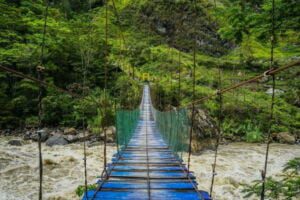
My four friends and I crawled down from the roof of the old van and we began the arduous journey. The first obstacle was crossing the Baliem River. There used to be a bridge, but it was washed away (along with good portion of the valley) a few months earlier. The current moves rapidly, and the water is frigid. A line of Papuans carrying pigs, potatoes, and miscellaneous tools made a line and held hands as they crossed. Being much taller than the locals, fording the river was a bit easier for me, but even with my height, the rivers depth was above my waste.
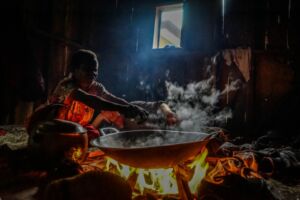
From the river, Kurima was another hour’s walk. As we entered Kurima village, we were greeted with a colourful festival. The festival (possibly a funeral) was a spectacle of vibrantly dressed locals. An archer proceeded to kill three pigs with his bow and arrow. The spectators then joined in to butcher the beasts and cook them in a bundle of smoking leaves. After only an hour of hiking we were already in the set of a National Geographic documentary.
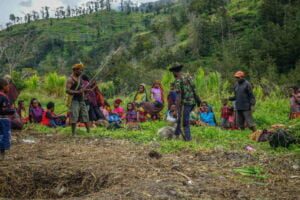
Hiking from Kurima to Kilise Village, you begin to realize how far from civilization you are becoming. The somewhat paved road ends here, and is replaced by muddy trails. Electricity, running water, and most other aspects of civilization slowly fade as you delve deeper into the wild.
My friends and I took a wrong turn and ended up having to take a secluded trail up a mountain side, covered in sweet potato crops. The extremely friendly locals were happy to point us in the right way to Kilise.
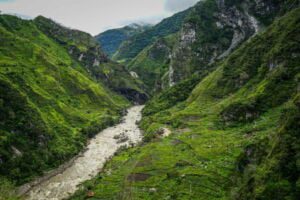
In Kilise, we asked around for food. An elder Papuan couple brought us into their Honai and let us use their firewood and cooking utensils. As the rain began to fall, we sat together on the straw floor of the smoky room together, cooking and laughing, trying to explain our cultural differences to these amazing people.
When the rain finally stopped, we crawled out from the warm, smoke filled interior of the Honai back into the stunning Baliem Mountains. The sights we witnessed while hiking from Kilise to Wamerek were incredibly jaw dropping. Clouds drifted alongside the densely forested mountains. The vertical drop on the side of the trail became daunting. As we looked down from the mountain, we could see small villages speckled throughout the valley.
Here things got dicey. The final stretch to Wamerek took us along a farmer’s trail, down the mountain side. The previous rains had turned the trail into a hazardous mess, which slowed us down drastically. We spread out as we descended, fearing a false move would bring us all tumbling down to our death. To make things worse, it began to rain again. The black clouds blotted out the sun, making this portion of the journey very frightening. After three hours of struggling down the mountain, we arrived to Wamerek; covered in mud, sweat, and blood from our many falls.
The local guesthouse took us in and cooked an incredible meal of rice, spinach, and maggi noodles. They made good use of the ingredients they had but, to be honest, anything at this point would have tasted amazing.

The next day can only be described as hell. From Wamerek to Wesagalep, the rain poured down on us as we began our three hour climb up the mountain. It was muddy, steep and very humid. Hiking here is challenging; not for the faint-hearted. Nearing Wesagalep felt surreal. High up in the clouds, you can only see a few feet in front of you. Every so often, a gap in the clouds would appear, allowing a brief glimpse of the stunning valley below.
Wesagalep is small. Only a few Honai and a single guesthouse are here. The altitude creates frigid temperatures, so living here is hard. The only people still in town at this time of day were an Elder blind couple who took us in for lunch and to dry off.
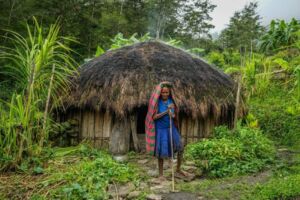
The elder man only wore a penis gourde and feathers atop his head. How he was able to survive in the rain and cold wearing only this I will never understand. When we finished our lunch, the Elder women guided us up the remaining part of the mountain to the summit.
The next part of the journey took us back down the valley to the river. We crossed through some very virgin rainforest and impossibly beautiful mountain vistas.
Arriving to Wuseram, we collapsed to the floor of the local guest house. Today’s hike was stunning, although painful, taking us around ten hours.
The next day to Syokosimo only took a few hours of hiking, but because the sun was shining and the valley views were clear, we took much longer. It was impossible not to stop and stare in awe at this scenery. Looking back, we could see the beast we had summited (which seemed so far away already)!
Eagle Eye View of the South Baliem ValleySyokosimo is nestled along the river, in the lower part of the valley, making it warm and very pleasant. This day we spent talking with the locals and learning about their culture. My fondest memory was having a cigarette, which was made from local harvested tobacco, with one of the Elder men. He wore only the penis gourde and cassowary feathers atop his head. After talking with him for some time, he brought the men in our group penis gourds which we were expected to wear…. Yes it was strange wearing only a fruit if you were wondering.
The final day we had to cross the Baliem River back to the trail we had already walked. The bridge that connects the valleys is a little less than horrifying. Every year, many people fall from the rickety thing to their deaths. Locals showed us how to cross it, which is done one by one and with extreme caution. After crossing, it was another two hours hike back to the bus stop. These two hours give you plenty of time to reminisce on your journey. Baliem Valley is not a place I am likely to forget!
Guide to Hiking the Southern Baliem Valley Trail
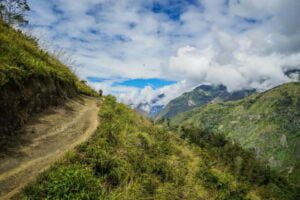
Day 1 – The first day you will have to wade across the river just before Kurima. After crossing, Kurima is about another 1-2 km along a nice paved road. Upon entering Kurima, you will be stopped by the military and asked for your Surat Jalan. From Kurima, the path becomes extremely muddy. Keep in mind that the next stop is Kilise, which is a steady uphill journey. You will reach Kilise from Kurima after 1-2 hours. The final stop will be Wamerek. Wamerek is another 3-4 hours away, the views are incredible. If you veer of the trail it can become incredibly hazardous. Take it slow, and ask locals which way to go. Its not a bad idea to split up the journey up and stay in Kilise for the night. Total hike time: 6 hours
Day 2 – I made it all the way to Wuserem this day. I highly don’t recommend doing this, however, as it was incredibly hard. I will break it up into two days for this post. From Wamerek, you will cross a very scenic bridge high above the roaring Baliem River. After this, get ready, because it’s uphill for 3-4 hours. It’s very steep, very muddy, and not the most pleasant experience. I was swearing to myself almost the whole time! After enduring all this pain you will reach Wesagalep. Wesagalep is high above the clouds, meaning that it’s cold here. If you decide to stay, make sure you have the gear for it. Total hike time: 5 hours
Day 3 – From Wesagalep, don’t follow the obvious trail, which just leads to some potatoes fields. Ask the locals to show you up the mountain. After another 1-2 hours of more painful, uphill, muddy trail, you will finally begin to descend. The one hour descent is steep, so be careful. Unfortunately, you must go down all the way to the river, and then back up another mountain pass. The climb takes about 1-2 hours. Finally, it’s all downhill form here all the way to Wuserem. Total hike time: 6 hours
Day 4 – This was my favorite day. The views are absolutely beautiful as you head back down into the valley towards Wamena. You will pass through many small villages on your way to Syokosimo. The wide, easy trail is mostly downhill and constantly provides jaw dropping views. Ask locals to point you in the right direction, but the trail is quite straight forward. Total hike time: 4 hours
Day 5 – The final day you have two options. The first is to head back the same way you came along the river and cross the rickety, scary bridge (one by one). This will drastically cut your hike time down. I chose this way as it only took 4 hours back. The bridge was very exciting as well! If you want more villages and excitement, cross the river right at Syokosimo and head up the mountain. You will be rewarded with more scenery and villages. This trail takes about 6 hours.
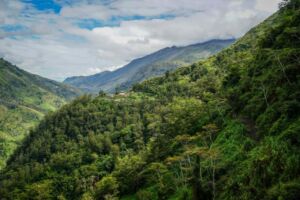
Preparing to Hike the Baliem Valley
When people refer to hiking in the Baliem Valley, they are usually referring to the Southern Baliem Valley. Here, the culture is more preserved and the villages have kept more traditional than elsewhere in the valley. Visiting here comes with its challenges, however. It’s very remote and requires some planning. Here are some frequently asked questions I have gotten:
Use a Guide, or Go Solo?
This is quite possibly the most frustrating aspect to visiting the valley. Locals will tell you its impossible to hike without a guide. They will tell you that the trails are too dangerous, navigation is very confusing and that there are no amenities. To be fair, they are not exactly wrong in saying this.
Using a guide can really help with all of these issues. Guides can arrange meals, translate, arrange porters and make the experience a lot more genuine. The catch however is that a guide will cost you at least $50 – 100 US per day, depending on the experience of the guide. There is also the risk getting stuck with an uncertified guide who turns out to be just some average joe looking to make a quick buck. If you decide to take a guide, sit down with him and tell him your expectations. Talk with more than one guide so that you can decide who suits your needs best.
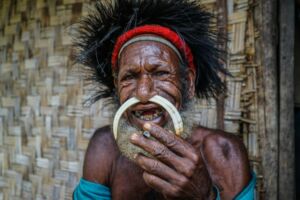
Going solo into the Baliem valley is a possible option as well, even though locals will tell you it’s not. There is plenty of local transportation to the trail head, and the trails are fairly easy to navigate, especially if you have a detailed map or GPS. Locals in the South Valley are happy to point you in the right direction as well. If you need to cook, you can stop in any village and offer a bit of money to use the fireplace in a traditional Honai house. Along the trail, many of the villages offer very primitive guesthouses for you to stay in.
What Gear to Bring?
Hiking here is extreme. It can be hot and humid one hour, freezing the next. It can be wet, cold, dry or boiling hot. It’s almost impossible to be fully prepared. The gear I brought was probably not enough, but it served me well. Here are a few items that helped me out immensely!
Fjalraven Backpack – Great size and built strong for crazy hikes like this. It can be waterproofed with the Greenland Wax
Fjalraven Jacket – Light and waterproof once it’s waxed with the Greenland Fjallraven Wax.
Greenland Wax – Amazing for waterproofing any cotton material.
Lifestraw and Bottle – enables you to drink any of the river and stream water safely… you need this one for sure!
Merino Wool Base Layer – great for keeping warm at night, its light and amazing!
Nomad Solar Panel – No plugins or electricity out here.. This panel charged my camera and phone in one hour.
Maps.me – free app that has all the villages and trails marked on an offline GPS. Amazing!!!
How Many Days Does it Take?
This largely depends on you, your fitness, experience, and weather conditions. The average person can complete the circuit through the Southern Baliem in 5 – 6 days. This much time will allow you to take things slow and enjoy the hike itself. Any less time and you will have to push yourself physically. The distances are not far here, but it’s hot, humid, and the vertical climbs are endless.
The weather is very unpredictable so come prepared for muddy trails that can delay hiking times by hours!
If you only have a limited amount of time, then opt for just hiking to a few of the entry villages. After one you head deep into the mountains, and getting back fast will become almost impossible.
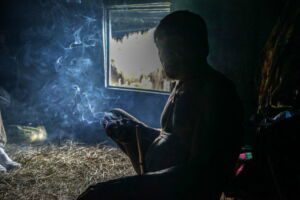
How Much Does it Cost?
If you factor in a guide, food, transport, porter, and all the extras, you can expect to pay about 700 US for 5-6 days. You can greatly reduce the price by brining your own food and equipment, not using a porter, and even eliminating the guide.
I did the trail on my own and brought my own food and equipment. My daily costs were about $15-20 US per day. So compared to the $700 US packages the guide offers, I did it all just over 100 US for the five days.
Accommodation and Food
This is quite possibly the most confusing and misunderstood part of the hike. Guides will tell you it is impossible to find accommodation on your own. This is, of course incorrect. Pick up a copy of the Lonely Planet: Indonesia. In the Papua section, you will find all the towns that offer official accommodation. When entering these towns, the owners will find you right away and direct you to the guest houses. If you want to stay with locals in a Honai, it will take some negotiating and some Bahasa language skills.
The guesthouses are very basic, usually offering a room with a carpeted or concrete floor. They will provide blankets to lie on, and sometimes a blanket to cover up with. It’s best to bring a sleeping bag or your own blanket.
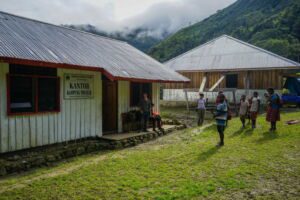
The availability of food and the means to prepare it is also misunderstood. Guides will say that you need all your own cooking equipment and food. With regards to cooking equipment, this is false. If you don’t mid using old pots and pans that are slightly unsanitary, then every single household can provide you with firewood, a fire and everything you’ll need to prepare meals.
You should bring some food, however. The locals mostly eat sweet potatoes, rice and sometimes spinach, so brining some comfort food is defiantly worth it. Trying the local food is a great experience though. Don’t miss out snacking on eating sweet potatoes around the fire while sharing stories!
Transport to Southern Baliem
Transport to the Southern Baliem valley is very easy to find. You can take a hired car for around $30 – 50 US. Or, you can just as easily hop on a bus from the Misi terminal. Riding the buses are a great experience! You can ride up top with the potatoes and vegetables for great mountain views. The bus only costs $2 US: a real bargain.
The trailhead begins in the town of Kurima… well, about 1km before Kurima. This is because the bridge that used to allow the bus to get all the way to Kurima is now gone from flooding. So the bus will drop you off near the river in which you must wade across. The journey to this point takes about 45 minutes.
Safety
West Papua is, in general, a safe place. But, things do happen here. Free Papua rebels or the OPM frequently have violent clashes with the government. Protests and demonstrations can also violent, usually resulting in deaths. Tourists are not being targeted, but kidnappings have happened in Baliem.
The real dangers here would be aggressive driving, drunken hooligans, muggings, and disease. Muggings are rare, but always be cautious at night. Its best not to hike at night. Aside from the danger of being a victim of a crime, the chances of getting lost increase exponentially at night. Papua is very remote and undeveloped; getting lost is a very serious and real danger.

Taking anti malaria pills and using bug repellent is essential. Malaria, Dengue and other mosquito borne illnesses are rampant. Sleeping in traditional houses, you will often get hundreds of bug bights that don’t always heal well.
Get your vaccines up to date, avoid drinking alcohol as its prohibited, and don’t go looking for trouble at night.
Baliem Valley Video
Useful Information
Location: Baliem Valley, West Papua, Indonesia
Language: Bahasa, Dani
Guide Book: Lonely Planet Indonesia
Flights: Lion Air flies from most major cities in Indonesia to Jayapura, and then on to Wamena
Top Tips: Plan ahead, travel here should not be taken lightly. West Papua is not a place to just show up to, there are many issues you will face as tourism is not developed in any way.
Check out what I carry in my bag Here!


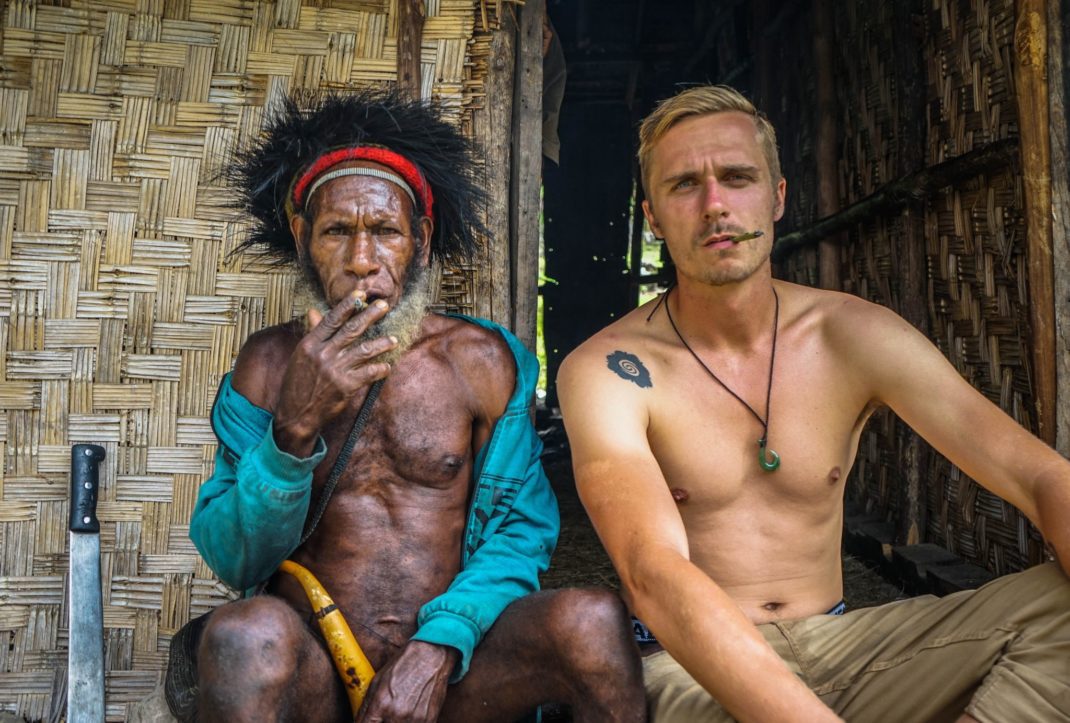

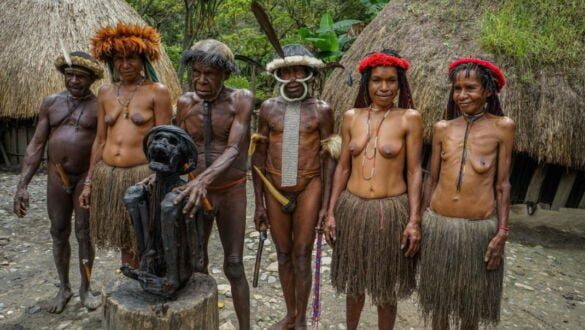
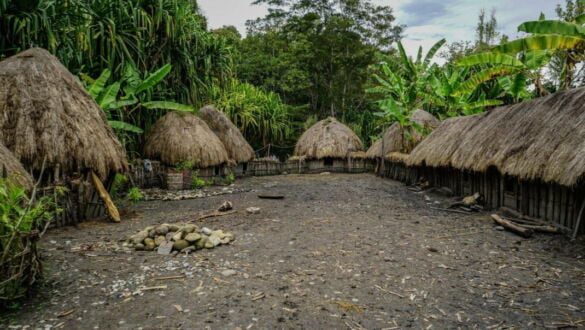
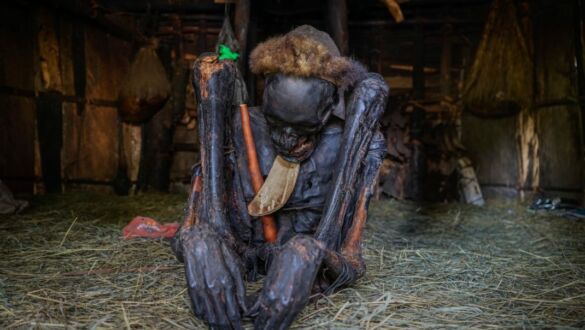
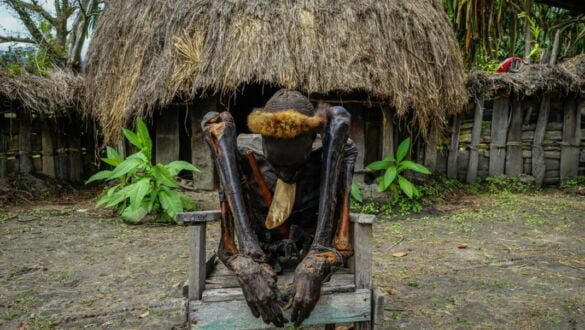
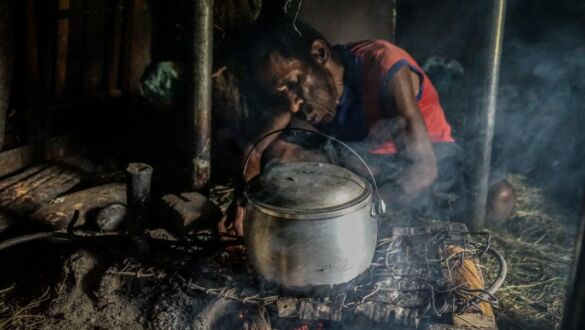
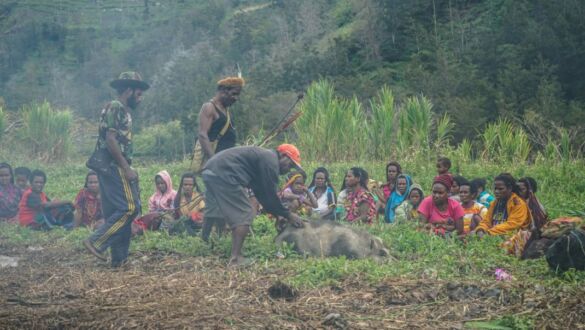
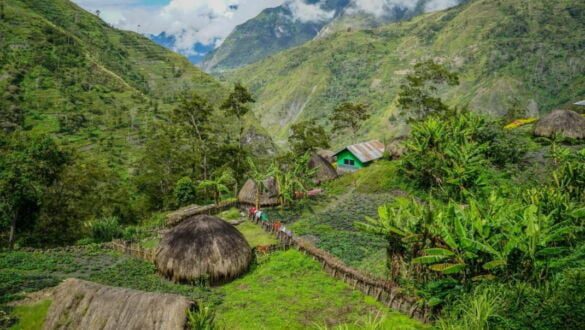
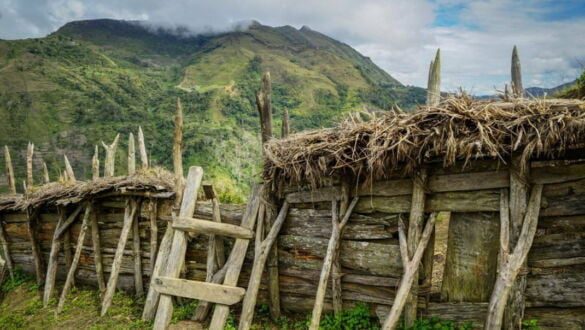







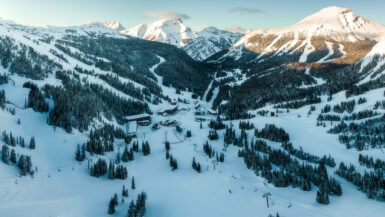
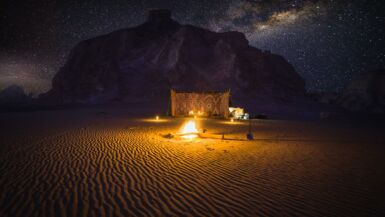
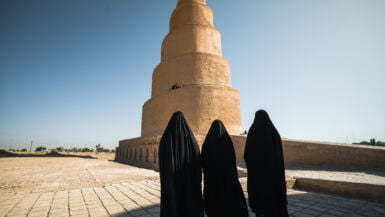
Woowwww amazing post with amazing pictures 🙂
Definitely I must go back to Indonesia, there are so many great places that I have missed 🙁
Have a nice day,
Flavia
Haai, thank you for writing about wamena…. been living here for 2years..
But it’s in Papua. Not west papua 🙂
Awesome pictures, Im headed that way late 2017 and will use your post to do my planning, thanks!
Great pictures! Thanks for the post, it will help me for my trip later next year!
Hi Stephen,
Just coming back from Baliem Valley, It was amazing, sure! A bit hard, being alone, but I feel really great now.
Just a remark about them being barely naked and not feeling coldness: they cover their skin with pig fat, to keep warm.
Have nice travels,
Nicolas
Wow, what a experience you must have had. Very inspiring – thanks for sharing!
https://carrieproject.com/
Hi, Stephen! Thank you so much for all those informations! Me and my wife are planning an independent hike in Baliem Valley for october 2017 and the information we can find on the internet is never enough!
A question, please: do you have the gps track from your hike or did you just use maps.me?
Thank you and good luck!
Adrian (montesambra@yahoo.de)
Thank you for sharing this amazing information. Welldone you really are an adventurous guys!! Looking forward to visit Papua .
Hi
I am going to the Baliem Valley in a couple of days , of course indipendently!
Any tips would be great
I only find your blog/web now
Thanks in advance
Mike
I have really enjoyed your blog – I did almost the same trip when I was 21 I am 46 now and it’s interesting to hear that the area is still very much the same. I loved my trip which I took with a travel company that organised guides , routes etc. I am glad that I did it and glad that people still are visiting this beautiful place.
Congratulations for your blog, is fantastic and thank you so much for share your experience and all the information!
Regards from Argentina!
It’s really wonderful journey. As Indonesian, I really appreciate it. Thank you for coming and also thanks for your kindness to explore Papua. It was absolutely inspiring. Great job!